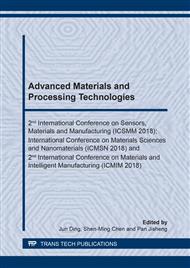[1]
Z. Heydari, D. Mohebbi-Kalhori, and M. S. Afarani: Engineered electrospun polycaprolactone (PCL)/octacalcium phosphate (OCP) scaffold for bone tissue engineering, Materials Science and Engineering C Vol. 81 (2017), pp.127-132.
DOI: 10.1016/j.msec.2017.07.041
Google Scholar
[2]
P. Timasart: Preparation and properties of polymer blend/bioglass composite for bone tissue engineering application (2012).
Google Scholar
[3]
K.K. Gómez-Lizárraga, C. Flores-Morales, M.L. Del Prado-Audelo, M.A. Álvarez-Pérez, M.C. Piña-Barba and C. Escobedo: Polycaprolactone - and polycaprolactone/ceramic-based 3D-bioplotted porous scaffolds for bone regeneration: A comparative study, Materials Science and Engineering C Vol. 79 (2017), pp.326-335.
DOI: 10.1016/j.msec.2017.05.003
Google Scholar
[4]
T. Kaur and A. Thirugnanam: Effect of porous activated charcoal reinforcement on mechanical and in-vitro biological properties of polyvinyl alcohol composite scaffolds, Journal of Materials Science & Technology Vol. 33 (2016), pp.734-743.
DOI: 10.1016/j.jmst.2016.06.020
Google Scholar
[5]
N. H. A. Ngadiman, M. Y. Noordin, A. Idris, A. S. A. Shakir, and D. Kurniawan: Influence of polyvinyl alcohol molecular weight on the electrospun nanofiber mechanical properties, Procedia Manufacturing Vol. 2 (2015), pp.568-572.
DOI: 10.1016/j.promfg.2015.07.098
Google Scholar
[6]
N. T. B. Linh and B.T. Lee: Electrospinning of polyvinyl alcohol/gelatin nanofiber composites and cross-linking for bone tissue engineering application, Journal of Biomaterials Applications (2011), pp.1-12.
DOI: 10.1177/0885328211401932
Google Scholar
[7]
J. Meesane: Tissue engineering scaffold from polymeric materials (2015), pp.119-158.
Google Scholar
[8]
D. Ronca, F. Langella, M. Chierchia, U. D'Amora, T. Russ, M. Domingos, A. Gloria, P. Bartolo, and L. Ambrosio: Bone Tissue Engineering: 3D PCL-based nanocomposite scaffolds with tailored properties, Procedia CIRP Vol. 49 (2016), pp.51-54.
DOI: 10.1016/j.procir.2015.07.028
Google Scholar
[9]
X. Liu and P. X. Ma: Polymeric Scaffolds for Bone Tissue Engineering, Annals of Biomedical Engineering, Vol. 32, No. 3 (2004), pp.477-486.
DOI: 10.1023/b:abme.0000017544.36001.8e
Google Scholar
[10]
H. Janik, and M. Marzec: A review: Fabrication of porous polyurethane scaffolds, Materials Science and Engineering C Vol. 48 (2015), pp.586-591.
DOI: 10.1016/j.msec.2014.12.037
Google Scholar
[11]
W. B. Zimmerman, B. N. Hewakandamby, V. Tesa, H.C.H. Bandulasena and O. A. Omotowa: On the design and simulation of an airlift loop bioreactor with microbubble generation by fluidic oscillation, Food and Bioproducts Processing Vol. 87 (2009), pp.251-227.
DOI: 10.1016/j.fbp.2009.03.006
Google Scholar
[12]
W. B. Zimmerman, V. Tesa, S. Butler, and H.C.H. Bandulasena: Microbubble Generation, Bentham Science Vol.2 (2008), pp.1-8(8).
Google Scholar
[13]
C. M. Murphy, M. G. Haugh, and F. J. O'Brien: The effect of mean pore size on cell attachment, proliferation and migration in collagen–glycosaminoglycan scaffolds for bone tissue engineering, Biomaterials Vol. 31 (2010), pp.461-466.
DOI: 10.1016/j.biomaterials.2009.09.063
Google Scholar
[14]
C. P. Ribeiro Jr. and P. L. C. Lage: Experimental study on bubble size distributions in a direct- contact evaporator, Brazilian Journal of Chemical Engineering Vol. 21, No. 1 (2004), p.69 – 81.
DOI: 10.1590/s0104-66322004000100008
Google Scholar


